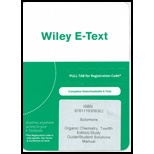
Interpretation:
The type of linkage involved in acetonide formation is to be determined and the reason for its susceptibility to acidic hydrolysis and its formation is to be explained.
Concept introduction:
舧 Electrophiles are electron-deficient species, which has positive or partially positive charge. Lewis acids are electrophiles, which accept electron pair.
舧 Nucleophiles are electron-rich species, which has negative or partially negative charge. Lewis bases are nucleophiles, which donate electron pair.
舧 A nucleoside consists of a nucleobase (also termed as nitrogenous base) and a five-carbon sugar (either ribose or deoxyribose).
舧 A
舧 In a nucleoside, the anomeric carbon is linked through a glycosidic bond to the N9 of a purine or N1 of a pyrimidine.
舧 Examples of nucleosides include cytidine, uridine, adenosine, guanosine and thymidine.
舧 Sugar (ribose/deoxyribose) and nitrogenous bases are linked through N-glycosidic bonds.
舧 These glycosidic bonds are formed by condensation reaction of first carbon of sugar molecule with the nitrogen atom
舧 This particular glycosidic bond is stable in basic solutions, but readily hydrolyzes in the presence of acids.
舧 Protection of hydroxyl group at C-2 and C-3 of ribose sugar can be done by treating it with a carbonyl compound. The two alcohol groups behave as
舧 In case the carbonyl involved is acetone, it is called acetonide.
舧 Such groups are stable to bases, but are readily hydrolyzed in mild acids.
舧 The structure of acetonide indicates cyclic diether, in which the alkoxy groups are connected through a single carbon atom and any carbon having two alkoxy groups is said to have involved in acetal formation.
舧 It is susceptible to mild acidic hydrolysis because, in acidic conditions, protons attack the alkoxy oxygen and protonate them. This results in the weakening of the bond of carbon to alkoxy, which readily hydrolyzes.
舧 The acetonide can be formed by the reaction of acetone with a nucleoside in acidic conditions. The proton liberated by the acidic group mediates an electrophilic attack on the carbonyl oxygen, which results in protonation. The protonated product further attacks the nucleoside and produces acetonide.
Want to see the full answer?
Check out a sample textbook solution
Chapter 25 Solutions
ORGANIC CHEMISTRY-ETEXT REG ACCESS
- What would be the major product of the following reaction? Please include a detailed explanation of what is happening in this question. Include steps and a drawing to show this reaction proceeds and how the final product is formed. The correct answer is B. I put answer D and I don't really understand what is going on in the question.arrow_forwardWhat is the product of the following reaction? Please explain what is happening in this question. Provide a detailed explanation and a drawing showing how the reagent is reacting with the catalysts to product the correct product. The correct answer is B.arrow_forwardWhat is the missing intermediate 1 and the final product 2. Please include a detailed explanation explaining the steps of malonic ester synthesis. Please include drawings of the intermediate and how it occurs and how the final product is former.arrow_forward
- What would be the reagents and conditions above and below the arrow that will complete the proposed acetoacetic ester synthesis? If it cannot be done efficiently, then I will choose that answer. There could be 2 or 4 reagents involved. Please provide a detailed explanation and drawings showing how it would proceed with the correct reagents.arrow_forwardFor benzene, the ∆H° of vaporization is 30.72 kJ/mol and the ∆S° of vaporization is 86.97 J/mol・K. At 1.00 atm and 228.0 K, what is the ∆G° of vaporization for benzene, in kJ/mol?arrow_forwardThe reaction Q(g) + R(g) → Z(l) is shown to be exothermic. Which of the following is true concerning the reaction. it is spontaneous only at High T, it is spontaneous at low T it is nonspontaneous at all T it is spontanrous at all T. it is non spontaneous only at low T.arrow_forward
- The reaction Q(g) + R(g) → Z(l) is shown to be exothermic. Which of the following is true concerning the reactionarrow_forwardWhich of the following has the largest standard molar entropy, S° (298.15 K) He H2 NaCl KBr Hgarrow_forwardWhich of the following is true for a particular reaction if ∆G° is -40.0 kJ/mol at 290 K and –20.0 kJ/mol at 390 K?arrow_forward

 Chemistry for Today: General, Organic, and Bioche...ChemistryISBN:9781305960060Author:Spencer L. Seager, Michael R. Slabaugh, Maren S. HansenPublisher:Cengage Learning
Chemistry for Today: General, Organic, and Bioche...ChemistryISBN:9781305960060Author:Spencer L. Seager, Michael R. Slabaugh, Maren S. HansenPublisher:Cengage Learning

